Sovereign Military Order of Malta Travel Guide
This is the taste2travel guide to the Sovereign Military Order of Malta.
Date Visited: December 2021
Introduction
I love geographical oddities, so when I learnt about a sovereign state which issues its own passports, stamps, currency, license plates, has a government, a permanent mission to the UN but no territory – I was fascinated.
The Sovereign Military Order of Malta (SMOM) has been a permanent observer at the United Nations (UN) since 1994 and has diplomatic relations with 113 countries and the European Union.
Most people rarely hear about the SMOM, a lay Catholic religious order which has existed for 930 years.
Also known as the Order of Malta or Knights of Malta, the order was traditionally of a military, chivalric and noble nature.
Despite its name, the Knights haven’t had any military function since leaving Malta in 1798 and today are known for their relief corps – the Maltesers – who provide humanitarian assistance around the globe.

The Rome headquarters of the SMOM, the Magistral Palace on Via dei Condotti,
The SMOM are headquartered at the Magistral Palace (Palazzo Malta), which is located in the heart of Rome on Via dei Condotti, a short stroll from the Spanish Steps.
The Palace serves as the residence of the Grand Master of the Order (position currently vacant) and also as the seat of government.
The Palace grounds have been granted extraterritorial status by the Italian government – just like Embassies around the world.

A view of the courtyard of the Magistral Palace from the main entrance on Via dei Condotti.
While the Palace isn’t open to visitors, you can step onto the grounds of this sovereign state by entering the horse carriageway which is the main entrance, A security gate ensures you cannot enter the Palace itself.
You can also enter the Palace complex by visiting the post office (see ‘Philately‘ below) which is located in the administration wing at the rear of the Palace.

A view of the Magistral Villa from the Villa garden.
Located on the Aventine Hill, overlooking the river Tiber, the city of Rome and the Vatican is the Magistral Villa, the 2nd property which serves as the Embassy of the SMOM to Italy and as the seat of the Roman branch of the Order of Malta.
Like the Magistral Palace, the Magistral Villa has been granted extraterritorial status by the Italian government.

The view of the dome of St. Peter’s Basilica through the famous ‘Keyhole of Malta’.
If there is anything the SMOM is known for – it’s the famous ‘Keyhole of Malta‘ (Il Buco Della Serratura), a small keyhole in a gate which offers a spectacular, telescopic view of the dome of St. Peter’s through a long tunnel of cypress hedge.
On any given day, a constant stream of tourist’s queue in the square outside the Villa to peek through the keyhole, trying to compose a perfect shot of the dome.
While tourists are aware of the keyhole, they have little idea about the Magistral Villa or the SMOM.
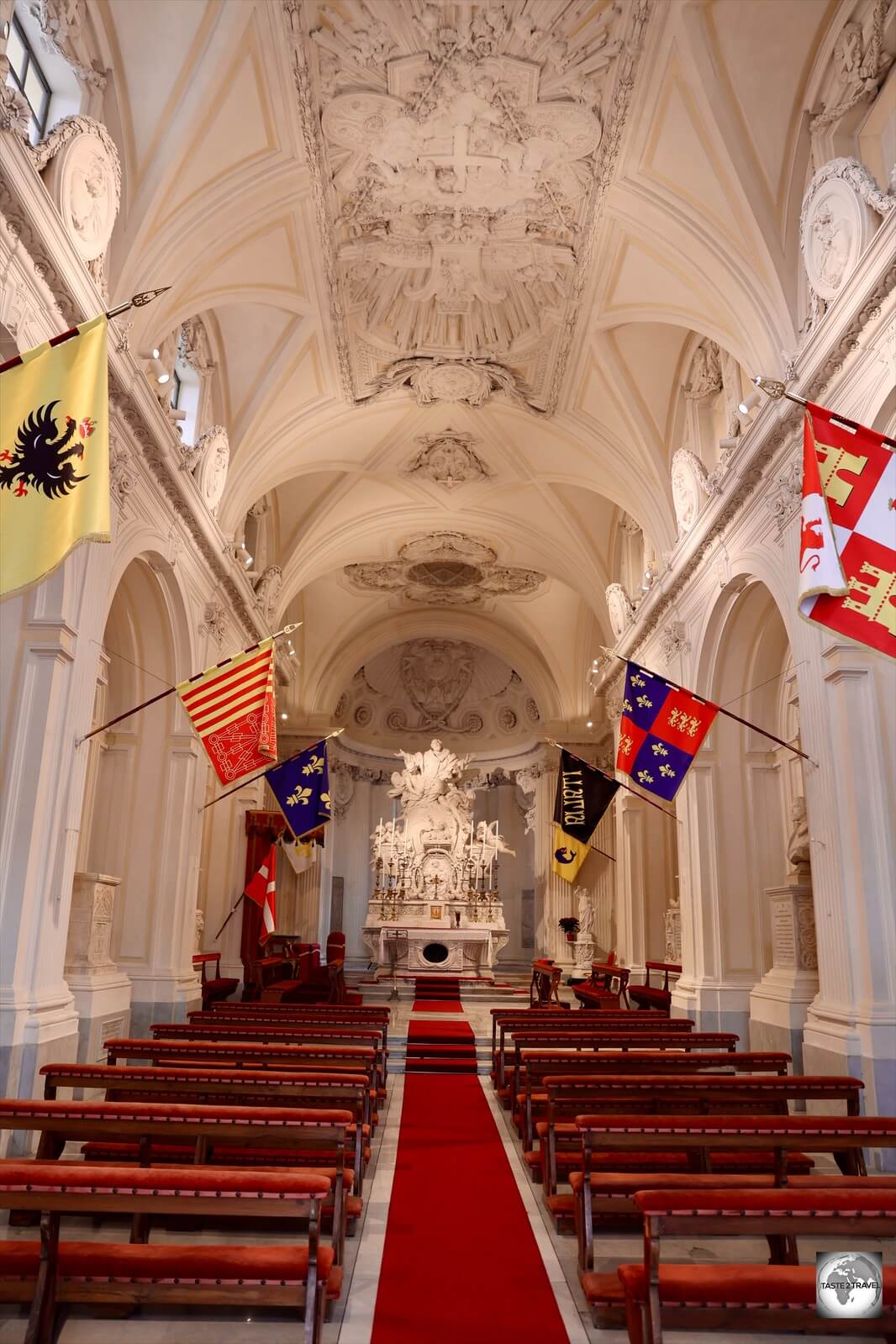
Santa Maria del Priorato church is a Neoclassical masterpiece by famed architect – Giovanni Battista Piranesi.
The Magistral Villa, which is surrounded by high security walls, isn’t open to the public but can be accessed by joining a private tour which is conducted every Friday morning (see ‘Sightseeing‘ below for details on booking tours).
I highly recommend the tour – it’s the best way to get that famous photo as you have the opportunity to stand in the middle of the hedge and compose the perfect shot.
What is covered on a tour of the Villa is the garden and the famous church – Santa Maria del Priorato (St. Mary of the Priory), a fine example of Neoclassical architecture by famed Venetian architect Giovanni Battista Piranesi. An explosion of stucco relief, Piranesi chose the church as his final resting place.

The view over the Forum of Augustus from the balcony of the Casa dei Cavalieri di Rodi.
A third, lesser-known property – the Casa dei Cavalieri di Rodi (House of the Knights of Rhodes), rises up out of the ancient rubble which is the Forum of Augustus, a short stroll from the Coliseum.
This property is also closed to the public but can be accessed by joining a private tour, which are conducted every Saturday morning (see ‘Sightseeing‘ below for details on booking tours).

The SMOM Visitor’s centre produces informative brochures in a variety of languages.
For those who like collecting passport stamps, you’ll be disappointed to learn that the SMOM doesn’t issue any stamps – not even souvenir stamps. Possibly this will change in the future!
You can learn more about the Order of Malta on their website or you can contact the Visitor’s Centre at – visitorscentre@orderofmalta.int
Activity Report
If you would like to learn more about the global humanitarian work conducted by the Order of Malta, you can refer to their annual Activity Report which is published in several languages:
Activity Report 2021: available online in English, Italian, French, Spanish and German
Location
Piazza del Grillo, 1, 00184 Roma RM, Italy
Piazza dei Cavalieri di Malta, 00153 Roma RM, Italy
Via dei Condotti, 68, 00187 Roma RM, Italy
The three properties of the Order of Malta are located in central Rome at the following locations:
- Magistral Palace (Palazzo Malta): Via dei Condotti,68 (Metro Station: Red line – Spagna)
- Magistral Villa (Villa Malta): Piazza dei Cavalieri di Malta,4, Aventine Hill (Metro Stations: Blue line – Circo Massimo or Piramide)
- Casa dei Cavalieri di Rodi (House of the Knights of Rhodes): Piazza del Grillo, 1 (Metro Station: Blue line – Colosseo)
History

A geographical map at the Casa dei Cavalieri di Rodi shows the ancient possessions of the Order of Malta.
The Order of Malta was founded in 1048 by Amalfian merchants in Jerusalem as a monastic order that ran a hospital to tend to Christian pilgrims in the Holy Land. The flag of Amalfi, which features an 8-pointed cross on a blue field was adopted by the Knights of St. John, who substituted the blue for red.

The flag of the Order of Malta was adopted from the flag of Amalfi.
Source: Wikipedia.
At the height of its power, the order was also tasked by Rome with the additional military function of defending Christians from the local Muslim population.
The Knights of St. John were just one of a number of Christian military orders founded during this period — including the fabled but now defunct Knights Templar. The Knights, also known as the Hospitallers both cared for the sick and defended Jerusalem until 1187, when the Sultan of Egypt conquered the holy city.
The Knights went into exile in 1291, relocating to Limassol, Cyprus. The impressive Kolossi Castle, which was originally built in 1210 by the Knights, served as a base for the Order.
The Order then bought the island of Rhodes in 1309 and relocated there. While on Rhodes, it is claimed the Knights harassed Muslim merchants in the Eastern Mediterranean. This harassment ended in 1523, when they were forced from Rhodes by the Ottoman sultan Süleyman the Magnificent.
England’s King Charles V, offer the island of Malta to the Knights in exchange for an annual falcon – now known as the Maltese falcon!
The Knights of St. John ruled Malta until they were dislodged by Napoleon’s army in 1798. The order settled in Rome in the mid-19th century, where it remains to this day.
Flags & Emblems
Flags

The state flag of the Sovereign Military Order of Malta, inside the church of Santa Maria del Priorato.
The constitution of the Order of Malta states: “The flag of the Order bears either the white Latin cross on a red field or the white eight-pointed cross (cross of Malta) on a red field.“

The flag of the Order’s Works, featuring a white Maltese cross, inside the Casa dei Cavalieri di Rodi.
The two flags of the Order of Malta are:
- State Flag: The State flag, which looks very similar to the Danish flag, consists of a white Latin cross on a red field. The state flag is derived from the design worn by the Knights Hospitaller during the Crusades.
- Flag of the Order’s Works: The Flag of the Order’s Works consists of a white Maltese cross on a red field.
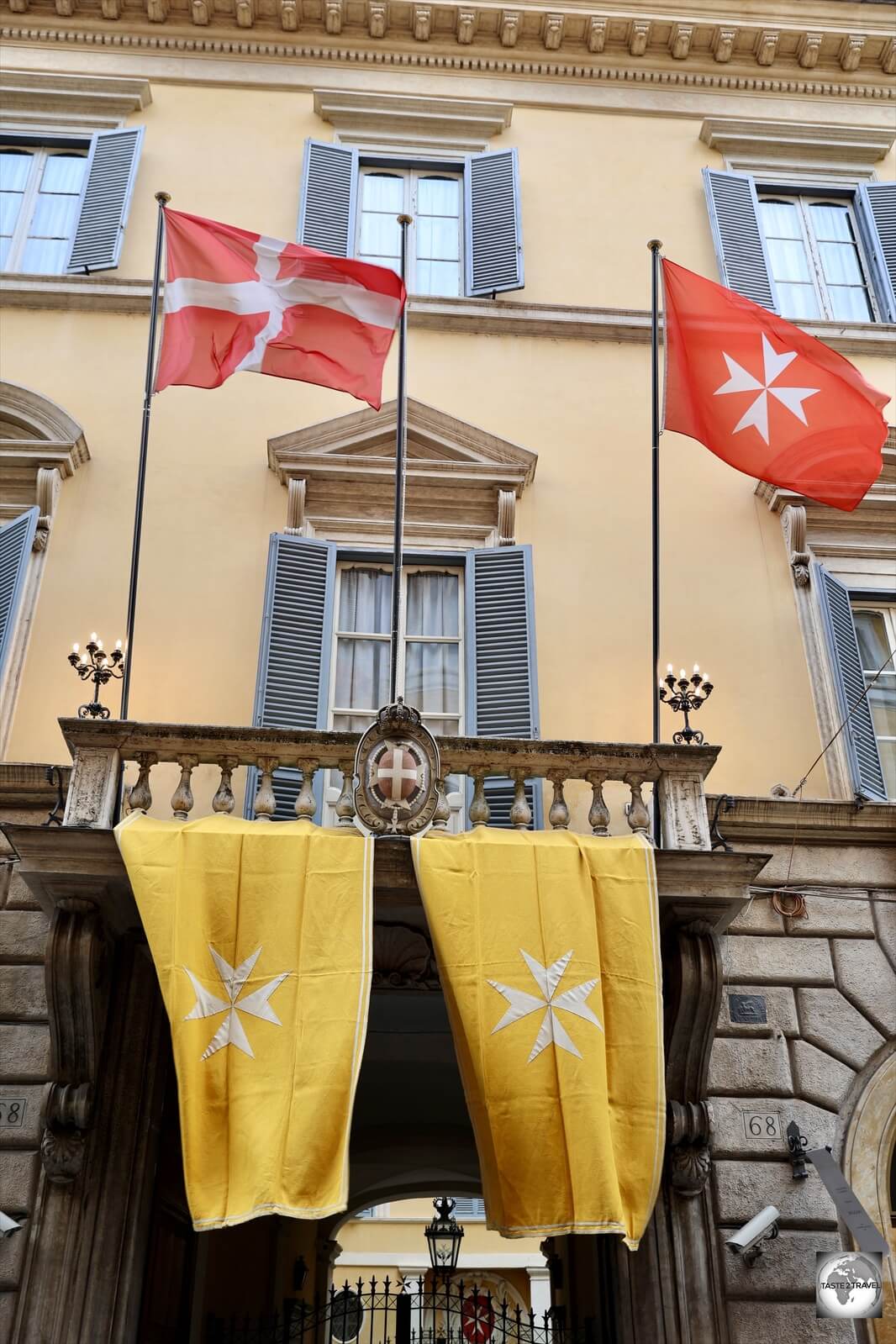
The two flags of the Order of Malta, above the main entrance to the Magistral Palace on Via dei Condotti.
Both flags are flown above the entrance to the Magistral Palace, where a third (middle) flagpole is reserved for the flag of the Grand Master, which is flown when he is in residence. Although not visible from the street, a large Maltese cross flag flies above the Palace. This can clearly be seen from the top of the Spanish steps.
Similarly, a large Maltese cross flag flies above the Magistral Villa (not visible from the street) and also from the balcony of the Casa dei Cavalieri di Rodi.
Coat-of-Arms

The coat of arms of the Sovereign Military Order of Malta.
Source: Wikipedia
The coat-of-arms of the Order displays a white Latin cross on a red oval field, surrounded by a rosary, which is all superimposed on a white eight-pointed cross and displayed under a princely cloak surmounted by a crown.
You can read more about the flags and emblems on the Order or Malta website.
Philately

An Order of Malta post box inside the Magistral Villa.
The Knights Hospitaller established an early form of postal service in Malta in the early 1530s. Today, the Order’s modern postal administration, known as the Poste Magistrali, issues several sets of stamps each year, which are denominated in euro.

Order of Malta stamps which I purchased from the Post Office at the Magistral Palace.
Stamps can be purchased at the post office at the Magistral Post Office, which is located on the 2nd floor of the administration wing of the Magistral Palace at Via delle Carrozze, 79.
Opening Hours: The post office is open:
- Monday, Tuesday and Thursday from 08:30 to 13:30
- Wednesday and Friday from 08:30 to 13:30 and 14:00 to 16:00
Current stamp issues can be viewed on the Order of Malta website. An online philately shop is being planned, but in the meantime, the post office can be contacted via email at postemagistrali@orderofmalta.int

Order of Malta postcards which can be purchased from the post office at the Magistral Palace.
Stamp Validity
It should be noted that the stamps of the Order of Malta are not valid for postage to all countries. The SMOM has bi-lateral postal agreements with 50 different countries (not including the US, UK or Australia) to which postage can be sent bearing SMOM stamps.
Mail stamped with Sovereign Order of Malta stamps can be sent to the countries listed here, provided it is posted at the Magistral Post Office. Additionally red ‘Poste Magistrali‘ post boxes can be found on the ground floor of the administration building at Via delle Carrozze, 79 or on the grounds of the Magistral Villa.
Currency

Bronze and silver scudo coins, issued by the Sovereign Military Order of Malta.
Source: https://www.orderofmalta.int/coins/
The official currency of the SMOM is the scudo, an historic currency which dates back to a time when the Order ruled over Malta – from 1530 until 1798.
Coins, which are minted in gold, silver and bronze, cannot be used for transactions and serve only as collector’s items. The scudo is subdivided into 12 tarì, and the tari subsequently subdivided into 20 grani (singular grano).
The following coins are currently available for purchase:
- Bronze: 10 grani
- Silver: 9 tarì, 1 and 2 scudi
- Gold: 5 and 10 scudi
Full details of the scudo coins on issue are available on the Order of Malta website

Gold and silver scudo coins, issued by the Sovereign Military Order of Malta.
Source: https://www.orderofmalta.int/coins/
A complete set of uncirculated scudo coins can be purchased for €80 from the Magistral Post Office, which is located on the 2nd floor of the administration wing of the Magistral Palace at Via delle Carrozze, 79.
The de-facto currency of the SMOM is the euro (€).
SMOM License Plates

A Sovereign Military Order of Malta vehicle license plate.
Source: http://www.plateshack.com/y2k/SMOM/smomy2k.html
The SMOM issues its own car license plates, although these are very scare.
I saw one car bearing such a plate which was parked inside the (locked) courtyard of the Magistral Palace. I wasn’t able to properly photograph the plate so I’ve sourced an image from the internet.
Government

The Magistral Palace serves as the seat of government of the Sovereign Military Order of Malta.
With the position of Grand Master currently vacant, the Order of Malta is presently headed by a Lieutenant of the Grand Master, which is Fra’ Marco Luzzago. The Grand Master usually resides inside the Magistral Palace which is the seat of the SMOM government.
The body of government is the Superior Council which consists of a group of 11 elected individuals (all men). Heading the council is the Grand Master along with the holders of the four High Offices (Grand Commander, Grand Chancellor, Grand Hospitaller and Receiver of the Common Treasure) and six members.
Sightseeing
There are three SMOM properties in downtown Rome, all of which are easily accessed via public transport.
Tours
Of the three properties, the Magistral Villa and the Casa dei Cavalieri di Rodi are open to the public. Both properties are open one day per week for private tours, with the Villa open on Friday mornings (except July and August) and the Casa open on Saturday mornings.
Due to it serving as the residence of the Grand Master and being the seat of government for the Order, the Magistral Palace is not open to the public.
Private tours of the SMOM properties can be organised by emailing the SMOM Visitor’s centre at visitorscentre@orderofmalta.int
Magistral Palace (Palazzo Malta)
Address: Via dei Condotti,68

The Magistral Palace (Palazzo Malta) serves as the headquarters and seat of government for the Sovereign Military Order of Malta.
With the highest concentration of luxury brands, Via dei Condotti is Rome’s most elegant shopping street – provided money is no object! Located at number 68, just two blocks in front of the Spanish Steps, the Magistral Palace lies in the heart of this ritzy shopping precinct.
While Via dei Condotti is a busy shopping street, almost everyone passes by the palace without ever noticing it, totally unaware of its importance or of its extraterritorial nature, and fully focussed on window shopping in the glitzy boutiques. The Order generates handsome revenue by renting out the ground floor retail premises to the likes of Jimmy Choo, Hermes and Mont Blanc.
The palace was left to the Order of Malta in 1629 by its representative in Rome, Fra’ Antonio Bosio. Since 1834, the palace has served as the residence of the Grand Master and seat of the Sovereign Order of Malta’s government.
The palace serves as the headquarters of the Order of Malta. From here, the Order’s diplomatic, religious, humanitarian and administrative undertakings are overseen. The palace grounds have been granted extraterritorial rights by the Italian Republic.
The Magistral Palace is closed to the public, but you are able to stand inside the main entrance which once served as a horse carriageway.

Plaque at the entrance to the Magistral Palace (Palazzo Malta).
For those who count ‘countries visited’, you can claim to have stood on the territory of the SMOM by standing inside the main entrance. From the entrance, two large gates block public access to the palace courtyard.

A Maltese cross adorns the rear wall of the courtyard at the Magistral Palace.
The rear wall of the courtyard features a Maltese cross which is mounted above a fountain. At the time of my visit in December of 2021, a small Christmas tree had been installed in front of the fountain. The tiny courtyard is normally used as a car park by visiting diplomats.

A marble plaque on the outside of the Magistral Palace, on the corner of Via dei Condotti and Via Boca di Leone.
SMOM Visitor’s Centre
The Magistral Palace is bounded by three streets; Via dei Condotti (front), Via Bocca di Leone (side) and Via delle Carrozze (rear). Previously, an SMOM Visitor’s Centre operated from the small premises at Via Bocca di Leone, 73.

The former SMOM Visitor’s centre, which is now closed.
At the start of the pandemic, the Order made the decision to close the shop, in an attempt to raise more revenue, by offering the premises for rental income. However, as of my visit in December 2021, the premises had yet to be rented with the space in front of the door being used for parking.
The current Visitors Centre is now located on the 2nd floor of the administration building, around the corner at Via delle Carrozze, 79.

The entrance to the Magistral Post Office at Via delle Carrozze, 79.
SMOM Post Office
For those wishing to purchase postage stamps, coins and postcards, you can do so from the Magistral Post Office, which is located on the 2nd floor of the administration wing at Via delle Carrozze, 79.
Although the palace isn’t open to visitors, the administration section of the palace is. Once inside the doors, you are on the territory of the Sovereign Military Order of Malta.

The entrance to the administration section of the Magistral Palace.
Inside, on the ground floor, a bright red ‘Poste Magistrali‘ post box can be used for postage, provided the destination country recognises the stamps of the SMOM (refer to the Philately section above).
The post office (a desk in the hallway) is located on the 2nd floor! The Visitor’s Centre is also located here.
Magistral Villa (Villa Malta)
Address: Piazza dei Cavalieri di Malta,4, Aventine Hill

The Magistral Villa serves as both the embassy of the SMOM to Italy and as the seat of the Roman branch to the Order.
The Magistral Villa, which is also known as the Villa del Priorato di Malta and Villa Malta has been in the possession of the Order of Malta since the 14th century and, together with the Magistral Palace, is one of its two institutional seats. Like the palace, the villa has also been granted extraterritorial status by Italy.
The Grand Master receives heads of state and representatives of governments at the Villa, as well as the ambassadors accredited to the Order.
Tours: Private tours of the Magistral Villa are conducted each Friday morning (except during July and August) and can be arranged by emailing the SMOM Visitor’s Centre at: visitorscentre@orderofmalta.int
While the garden and church are open to visitors, the villa cannot be visited.

Plaques at the entrance to the Magistral Villa on Aventine Hill.
Originally built in 939 as a Benedictian monastery, the property was transferred to the Knights Templar in the 12th century. In 1312 the Order of Templars was suspended and the monastery was given to the Knights of Rhodes, at a time when the Order was headquartered on Rhodes.
In 1522, when the Order moved from Rhodes to Malta, the name of the order was changed to the Sovereign Order of Malta (Sovrano Ordine di Malta). The Roman seat of the Order, which was called the Gran Priorato di Roma dei Cavalieri di Malta, was also located at the property.
In 1765, under the direction of the Grand Prior Giovan Battista Rezzonico, nephew of pope Clement XIII, and with the Venetian architect Giovanni Battista Piranesi, the entire property was radically transformed.
Santa Maria del Priorato
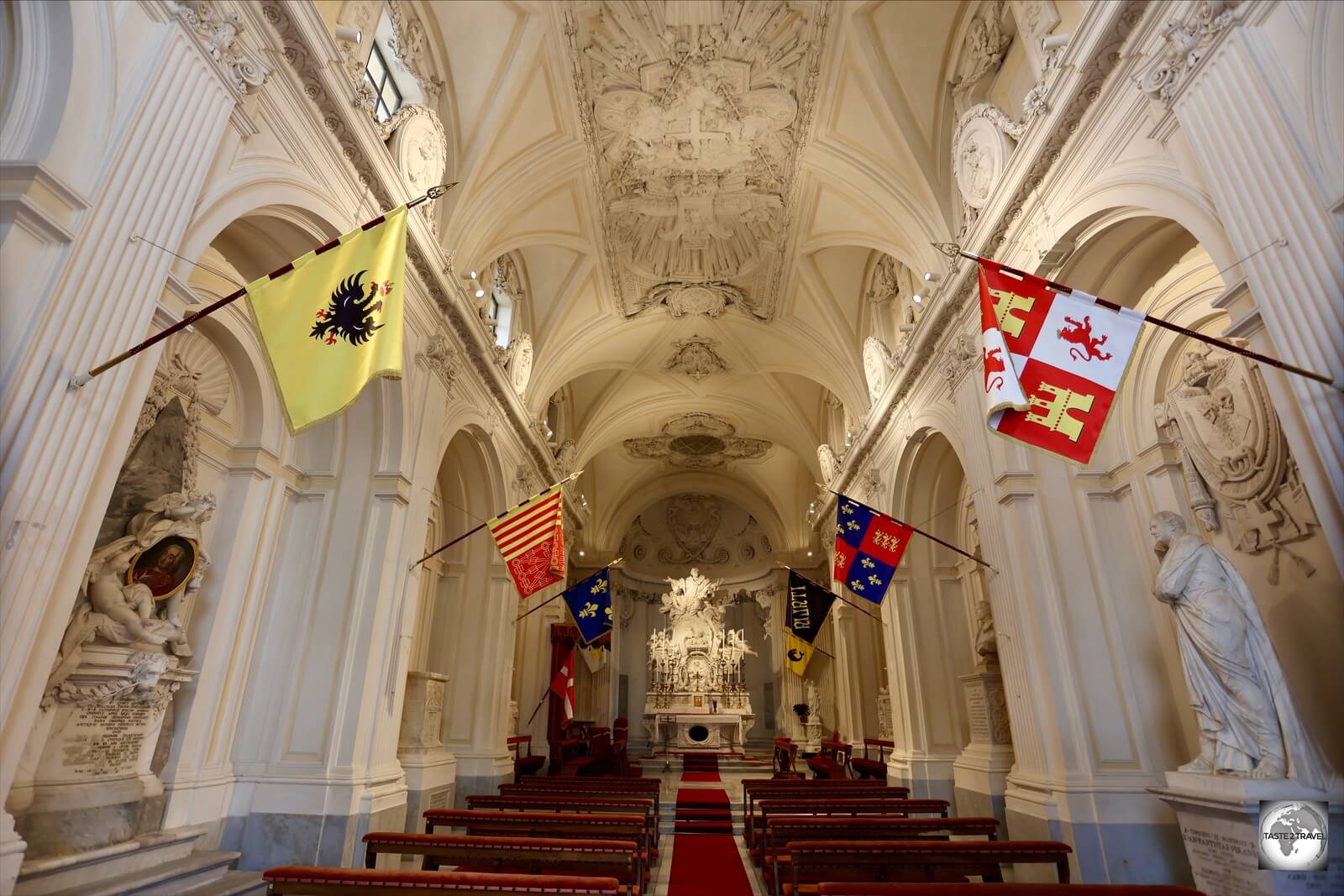
Located on the grounds of the Magistral Villa, the Santa Maria del Priorato church was designed by famed Venetian architect Giovanni Battista Piranesi.
The church of Santa Maria del Priorato is one of the oldest churches in Rome, having first been established in the 10th century when the property was a monastery.

A view of Santa Maria del Priorato church at the Magistral Villa.
As part of the reconstruction project overseen by Giovanni Battista Piranesi, a former medieval church was modified and renamed as Santa Maria del Priorato (St. Mary of the Priory). The Virgin Mary is venerated by the Order of Malta as its patroness.

Detail of an entrance at the Villa Magistral, featuring the Virgin Mary, who is venerated by the Order of Malta as its patroness.
The church is used today as a place of worship by the Order and includes a Magistral Throne, which is used by the Grand Master. Whenever the Order is without a Grand Master, the throne is turned to face the back of the canopy. A key event for the church is the feast of St. John the Baptist, patron saint of the Order, which is celebrated on the 24th of June.

The magistral throne of the Grand Master of the Sovereign Military Order of Malta inside Santa Maria del Priorato church.
The church is unique in that it is the only example of the architectural work of Piranesi – it is the only building he ever built. It is also considered to be the earliest example in Rome of Neoclassical architecture. At the time is was completed, Piranesi’s stucco craze faced some criticism – it was just a little too ‘neo‘ for some.
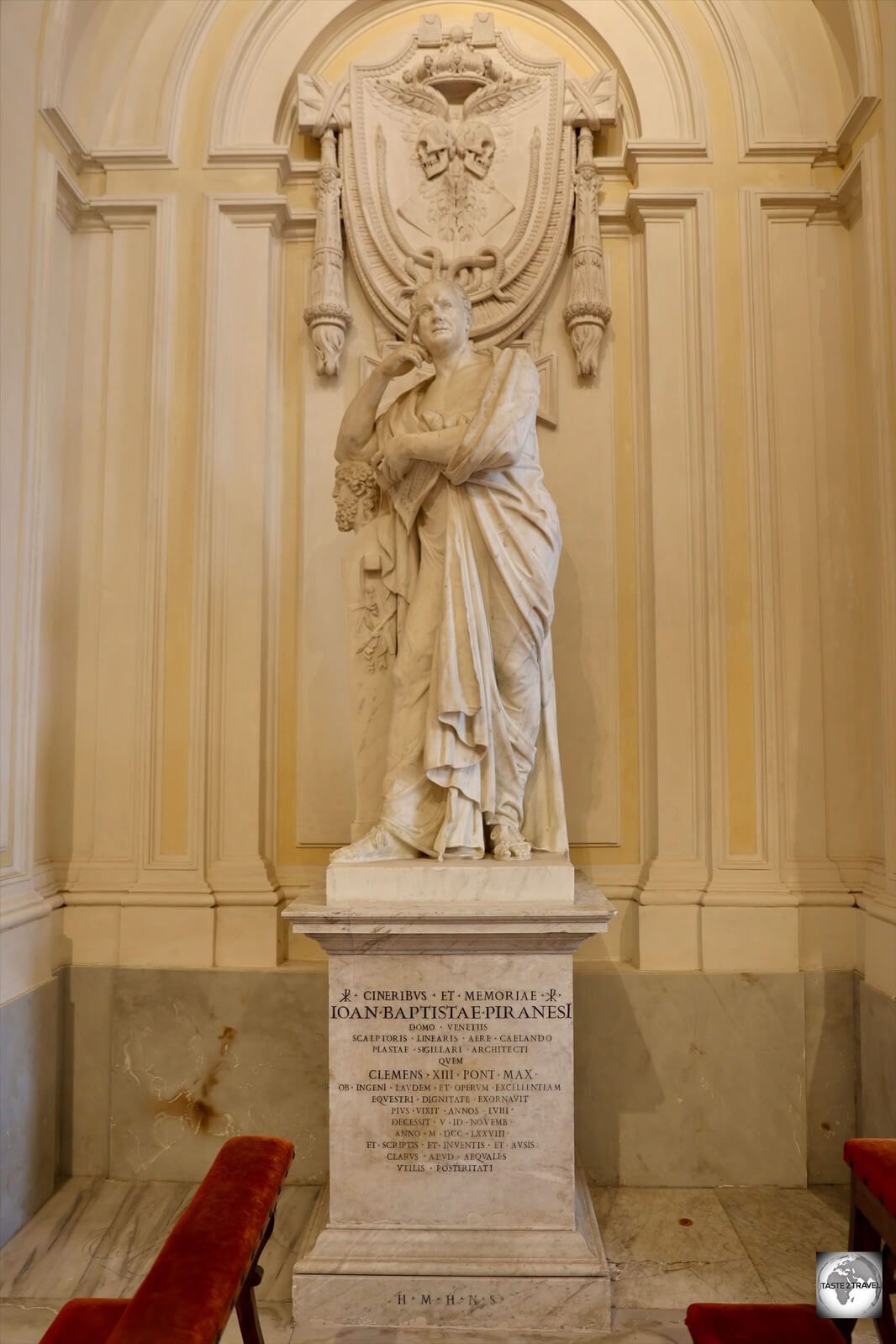
Funeral Monument of Giovanni Battista Piranesi inside Santa Maria del Priorato at the Magistral Villa.
So enamoured was Piranesi with his masterpiece, he wanted always to remain in the church. Today, his ashes are interred underneath a statue of himself, wearing a Roman toga, which was sculptured by Giuseppe Angelini (1735-1811).
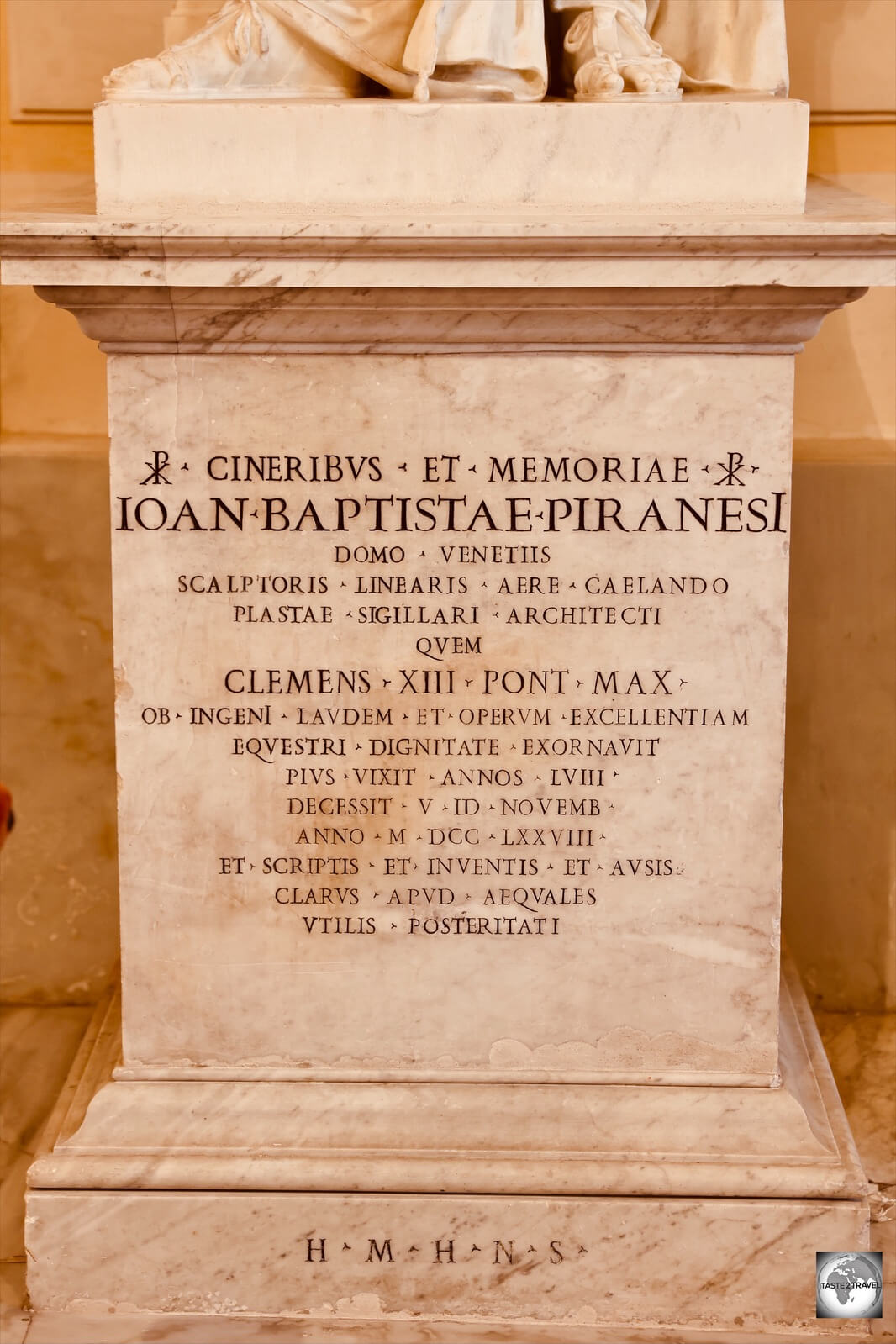
The tombstone from the funeral monument of Giovanni Battista Piranesi.
The interior of the church is striking for its whiteness, with all statues, and the many stucco reliefs, in the same shade of white. The centre-piece is the high altar which is also in stucco and was created by Tommaso Righi, an apprentice of Piranesi.

The elaborately ornate high altar is the work of Tommaso Righi (1727-1802).
The original design of the altar, as described by Piranesi himself was “a sarcophagus as the base and table of the altar, an elaborate superstructure with a medallion (on which a Madonna and Child would be carved), and a depiction of the Apotheosis of St. Basil (the namesake of the order’s original church at the Casa dei Cavalieri di Rodi)”.

Stucco relief surrounds an Order of Malta Grand Master, inside Santa Maria del Priorato church.
Keyhole of Malta

The view of St. Peters Basilica through the Cypress-hedge tunnel, taken from the garden.
Most visitors to the Magistral Villa never enter the Villa, but instead join a queue in the square outside to wait their turn to view the dome of St. Peter’s through the famous Keyhole of Malta (Il Buco Della Serratura).
The majestic dome of St. Peter’s, designed by Michelangelo and completed in the 16th century is visible all across Rome, but, what’s possibly the best view, is completely invisible at first sight – until you look through the tiny (1 cm-wide) keyhole.
Incredibly, a wonderful telescoped view of St. Peter’s opens up before you, symmetrically framed by the Cypress hedges of the Villa garden. The unique vista is the brainchild of Piranesi.

Tourists outside the Magistral Villa, waiting to view the dome of Saint Peter’s Basilica through the Keyhole of Malta.
Guarding access to the Villa from the Piazza dei Cavalieri di Malta is a majestic entrance screen which was also designed by Piranesi. The famous keyhole is installed in the arch-headed central gate.

A view of the famous ‘Keyhole of Malta’ at the Magistral Villa.
Trying to photograph a distant dome, through a tunnel hedge, through a 1 cm wide keyhole, isn’t an easy task, especially when you have a long line of people waiting behind you wishing to do the same thing. I took several photos through the keyhole which were all bad.
The photo I have included above was taken inside the grounds of the Villa, which meant I had to briefly block someone’s view. If you want to get the perfect shot, it’s best to book a private tour.
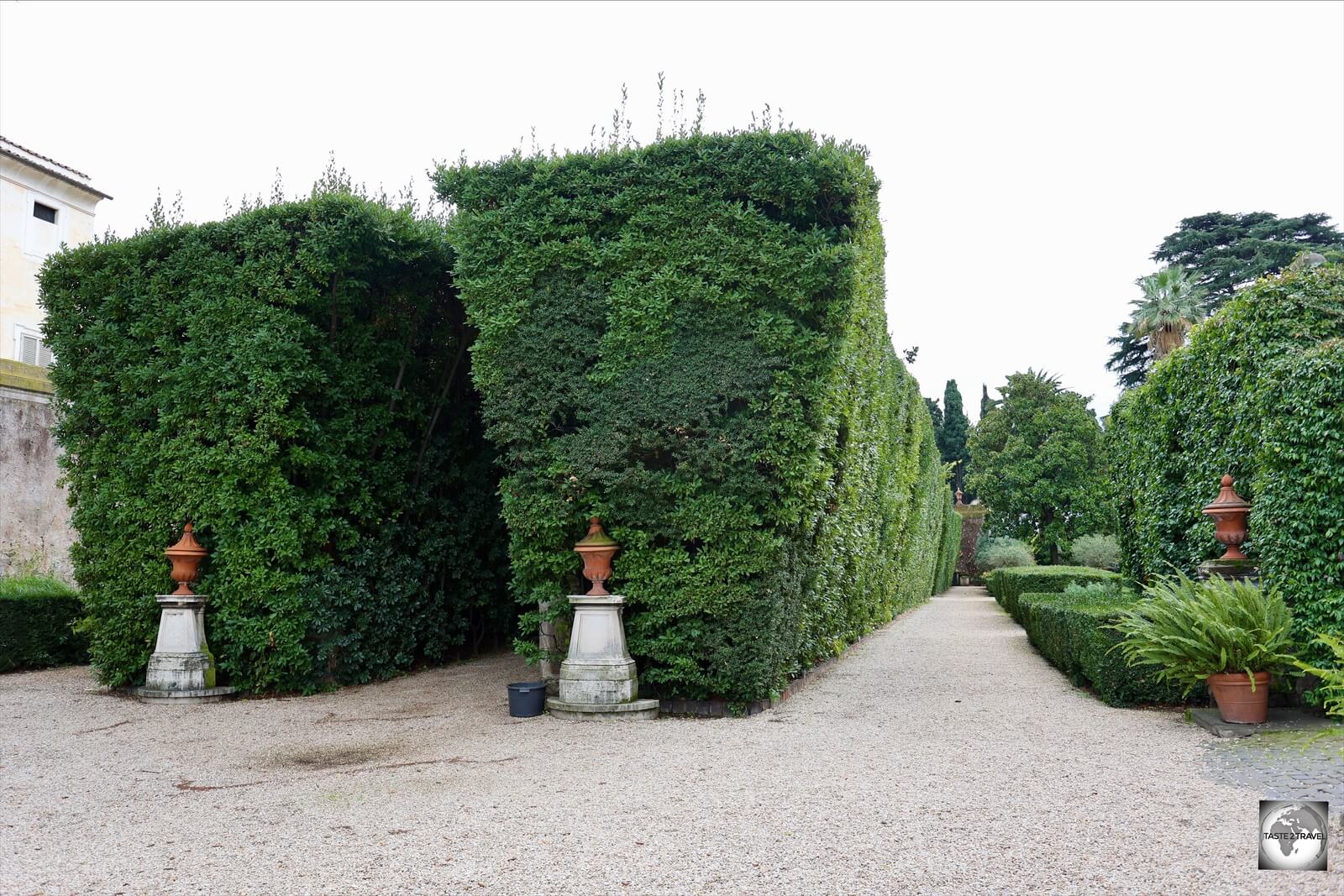
A view of the front end of the Cypress-hedge tunnel.
What is unique about this view is that you can view three ‘lands’ simultaneously; with the SMOM in the foreground, Italy in the mid-ground and Vatican City in the background.
Magistral Villa Garden

The view of St. Peter’s from the garden of the Magistral Villa.
As part of the great makeover project, led by Piranesi, the Villa garden was also completely remodelled. Exotic plants, including different varieties of palm trees were planted.

A garden fountain at the Magistral Villa.
From the garden, you can also enjoy an unobstructed view of the dome of St. Peter’s without peering through a tiny keyhole. Worth taking a private tour!

The gardens at the Magistral Villa were designed by Piranesi.
The centre-piece of the garden is a towering 500-year-old Lebanese cedar tree. The garden features fountains and a well which dates back to the time of the monastery.

The centre-piece of the Magistral Villa garden is this towering 500-year-old Lebanese cedar tree.
A highlight of the garden is the small, 17th-century coffee-house whose walls are lined with the coats-of-arms of the Professed Knights of the Order of Malta from 1800 to today.

A view of the garden coffee house which is located in the villa gardens.
The Villa serves as the main function centre for the Order, with garden functions being popular, especially during the Covid pandemic. For such functions, the coffee-room provides the perfect catering venue.

The walls of the garden coffee house display the coats-of-arms of the Professed Knights of the Order of Malta from 1800 to today.
The coffee-house lies alongside the cypress hedge tunnel, which you need to pass through (briefly blocking someone’s view), in order to enter.
Magistral Villa

A view of the Magistral Villa which serves as the Embassy of the SMOM to Italy.
As part of the reconstruction project conducted by Piranesi in the 17th century, the Magistral Villa, a former monastery, was transformed. Today, the Villa serves as the Embassy of the SMOM to Italy and is the seat of the Roman branch of the Order. Public access is prohibited.

The Magistral Villa serves as the SMOM Embassy to Italy.
Casa dei Cavalieri di Rodi (House of the Knights of Rhodes)
Address: Piazza del Grillo, 1

Casa dei Cavalieri di Rodi was built by the Knights Hospitaller at the end of the 13th century.
While most reports on the Order of Malta mention the Magistral Villa and the Magistral Palace, there is a 3rd, lesser-known property, which is often overlooked – the Casa dei Cavalieri di Rodi (House of the Knights of Rhodes).
The haphazard external appearance of the House of the Knights of Rhodes is the result of a stratification of monuments on the area that housed the Forum of Augustus in the imperial age.

The Forum of Augustus at dusk.
Located at the Forum of Augustus, across the road from the wedding cake monument which is the Victor Emmanuel II National Monument (Altare della Patria), you could be mistaken for thinking the Casa is a ruin. However, a fluttering Maltese Cross flag on the balcony of the upper floor indicates that this building is indeed functional and occupied.

The entrance to the Casa dei Cavalieri di Rodi on Piazza del Grillo.
In the 9th century, monks began the construction of a church and a monastery dedicated to St. Basil on the area of the Forum of Augustus.

Plaques at the entrance to the Casa dei Cavalieri di Rodi.
As was the practice at the time, parts of old wall structures were utilised in the construction process. In 1230, the complex was then incorporated into a property of the Knights of St. John.
Loggia – Terrace

The view over the Forum of Augustus from the balcony of the Casa dei Cavalieri di Rodi.
In 1466, renovations were commissioned by Cardinal Marco Barbo, a Roman prior of the Order, which included the construction of the upper floor terrace (loggia) which offers panoramic views of the Forum of Augustus.
When in 1566 the Knights of St. John moved its headquarters to the Magistral Villa on Aventine hill, Pope Pius V entrusted the building to the Institute of the Dominican Sisters.
The Dominican Sisters occupied the property until 1930, at which time the convent was demolished to make way for the Via dei Fori, a wide avenue which runs in a straight line from the Piazza Venezia to the Colosseum.
During the 1940s and 1950s, the City of Rome made renovations to the Casa dei Cavalieri di Rodi, which made it possible to recover the entire house, which was then granted back to the Sovereign Military Order of Malta in 1946.

The front entrance to the Casa dei Cavalieri di Malta.
Palatine Chapel of Saint John the Baptist

A view of the “Palatine Chapel of Saint John the Baptist of the Knights of Rhodes” inside the Casa dei Cavalieri di Rodi.
On the ground floor of the Casa is the Palatine Chapel, dedicated to St. John the Baptist, patron of the Order of the Knights. A niche on the rear wall includes an altar with a statue of St John.

A statue of St. John the Baptist on the altar of the Palatine Chapel.
Despite its appearance, the chapel is a modern edition to the property, built in 1946 into one of the rooms of the Casa dei Cavalieri di Rodi.
Hall of Honour

A view of the Hall of Honour.
Upstairs, on the 1st floor of the Casa dei Cavalieri di Rodi, is the Hall of Honour. Characterised by its lofty ceiling, the flags of the eight “languages” of the Order hang from the two side walls.

The islands of Rhodes and Malta, former headquarters of the Order, are displayed in the Hall of Honour.
Two large paintings, which date from the 20th century, show the island of Rhodes and Malta; while a 2nd painting shows the possessions of the ancient Order. From the Hall of Honour, a doorway leads into the Hall of the Loggetta.
Hall of the Loggetta

A Magistral Throne, used by the Grand Master of the Order, inside the Hall of the Loggetta.
The Hall of the Loggetta features sculptures and paintings from different periods. It is used as a function room by the Order.

Photos of two former Grand Masters of the Order lie on a table beneath a painting of Christ.
Tours
Private tours of the Casa dei Cavalieri di Rodi are conducted each Saturday morning.
Bookings need to be made in advance by emailing the SMOM Visitor’s Centre at – visitorscentre@orderofmalta.int
Visa Requirements
There’s no immigration control between Italy and the two extra-territorial properties controlled by the Sovereign Military Order of Malta. For those who like collecting passport stamps, you’re out of luck! Passport stamps are not issued by the SMOM.
SMOM Passports

The rarest passports in the world belong to the Sovereign Military Order of Malta.
Source: Wikipedia
The world’s rarest passport, with only 500 in circulation, belongs to the Sovereign Military Order of Malta, the one country in the world without land!
Diplomatic Passports
There are just three people who carry an Order of Malta diplomatic passport:
- The Grand Master
- The Grand Commander
- The Grand Chancellor
Service Passports
Service passports of the Sovereign Military Order of Malta are issued only to people who are in charge of a special mission within the Sovereign Military Order of Malta. The validity of the passport is strictly linked to the duration of the assignment.
That concludes my report for the Sovereign Military Order of Malta.
Safe Travels!
Darren
Follow me on Instagram:
[instagram-feed feed=1]
Sovereign Military Order of Malta Travel Guide Sovereign Military Order of Malta Travel Guide Sovereign Military Order of Malta Travel Guide
Sovereign Military Order of Malta Travel Guide Sovereign Military Order of Malta Travel Guide Sovereign Military Order of Malta Travel Guide
Sovereign Military Order of Malta Travel Guide Sovereign Military Order of Malta Travel Guide Sovereign Military Order of Malta Travel Guide
Sovereign Military Order of Malta
Author: Darren McLean
Darren McLean is an Australian, full-time, digital nomad who has spent 37 years on a slow meander around the globe, visiting all seven continents, 192/ 193 UN countries and 245/ 251 UN+ countries and territories.
He founded taste2travel to pique one’s curiosity and inspire wanderlust.







